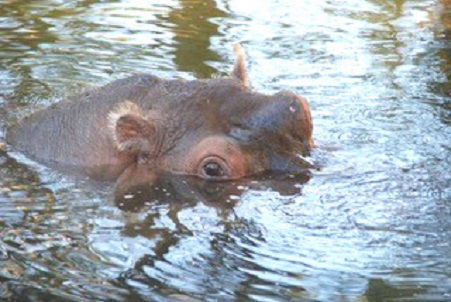SCORES & OUTDOORS: The challenges of getting a hippopotamus for Christmas

Lu, short for Lucifer, has grown so popular, he even has his own Facebook page where pictures like this are shared. (photo courtesy of Lu’s Facebook page.)
 by Roland D. Hallee
by Roland D. Hallee
Roland has taken an early vacation. This is reprinted from the December 24, 2015, issue.
When 10-year-old Gayla Peevey sang her 1953 Christmas song, I Want a Hippopotamus for Christmas, did she really know what she was wishing for?
When the song was released nationally, it shot to the top of the charts and the Oklahoma City zoo acquired a baby hippo named Matilda. Legend has it the song was recorded as a fundraiser to bring the zoo a hippo. But, in a 2007 radio interview in Detroit, Peevey clarified that the song was not originally recorded as a fundraiser. Instead, a local promoter picked up on the popularity of the song and Peevey’s local roots, and launched a campaign to present her with an actual hippopotamus on Christmas.
The campaign succeeded, and she was presented with an actual hippopotamus, which she donated to the city zoo. It lived for nearly 50 years.
That brings us to the point. Had she decided to keep it, it wouldn’t have exactly been a house pet.
 She would have had to put in a gigantic pool because the hippos spend most of their day wallowing in the water to keep their body temperature down and to keep their skin from drying out. With the exception of eating, most of hippopotamuses’ lives occur in the water.
She would have had to put in a gigantic pool because the hippos spend most of their day wallowing in the water to keep their body temperature down and to keep their skin from drying out. With the exception of eating, most of hippopotamuses’ lives occur in the water.
Which brings us to another problem. Hippos leave the water at dusk and travel inland, sometimes up to five miles to graze on short grass, their main source of food. That probably wouldn’t have gone over too well with the neighbors and their lawns. Hippos can consume upwards of 150 pounds of grass each night.
The hippopotamus would probably have had problems living in an urban setting. They are among the largest living mammals, only elephants, rhinoceroses and some whales are heavier. They are also one of the most aggressive creatures in the world, and is often regarded as one of the most dangerous animals in Africa. So, you’d probably want to have it on a leash.
But, that probably wouldn’t do any good. An adult male can weigh between 3,300 and 4,000 pounds, with older males reaching 7,100 to 9,900 pounds, and would have no problems breaking a tether. Although a female hippo stops growing at around 25 years of age, the males appear to continue to grow throughout their lives.
And, if it got loose, don’t try to outrun it. Despite their bulk, hippopotamuses can run faster than a human on land. Estimates have put their running speed from 18 to 25 miles per hour. The upside? It can only maintain that speed for a few hundred yards. (Actually, that’s all it would need to run you down).
Peevey’s local public works department may have frowned on her having a hippo. Because of their size and their habit of taking the same paths to feed, hippos can have a significant impact on the land they walk across, both by keeping the land clear of vegetation and depressing the ground. But worse, over prolonged periods, hippos could divert the paths of streams and storm run off.
You’d also have to modify your will and make arrangements for its care. Their lifespan is typically 40 to 50 years, and could possibly outlive you. While some have been known to live longer. Bertie the Hippo, who resided at the Denver Zoo, was the oldest living hippo in captivity at age 58 years, but was euthanized in 2015 due to declining health and quality of life. Donna the Hippo, had been the oldest living hippo in captivity, but died on Aug. 3, 2012, at the Mesker Park Zoo, in Evansville, Indiana.
The oldest recorded lifespan was Tanga, who lived in Munich, Germany, and died in 1995 at the age of 61. But there are conflicting reports on Donna. Some say she was 61 years old, while others claim she was 62, which would have made her the longest living hippo in captivity in history. Until recently, Blackie, who resided at the Cleveland Zoo, was the longest living, at age 59, but died on January 13, 2014.
Now, visitors flock to the Ellie Schiller Homosassa Springs Wildlife State Park, in Florida, to see the oldest hippo in the Americas: Lu, which is short for Lucifer. The 60-year-old bull hippopotamus has lived at the park for almost his entire life.
Born in San Diego, California, in 1960, Lu was relocated to Homosassa Springs to join the Ivan Tors Animal Actors. After nearly two decades of starring in movies and television specials, Lu suddenly faced eviction from his beloved home.
So, if you really want a hippopotamus for Christmas, you’d better do your homework.
Roland’s trivia question of the week:
Who was the first boxer to defeat Muhammad Ali in a heavyweight championship fight?
Responsible journalism is hard work!
It is also expensive!
If you enjoy reading The Town Line and the good news we bring you each week, would you consider a donation to help us continue the work we’re doing?
The Town Line is a 501(c)(3) nonprofit private foundation, and all donations are tax deductible under the Internal Revenue Service code.
To help, please visit our online donation page or mail a check payable to The Town Line, PO Box 89, South China, ME 04358. Your contribution is appreciated!


Leave a Reply
Want to join the discussion?Feel free to contribute!